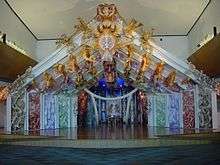Culture of New Zealand
| Part of a series on the |
| Culture of New Zealand |
|---|
 |
|
Traditions |
|
Festivals |
|
Music and performing arts |
|
Monuments |
|
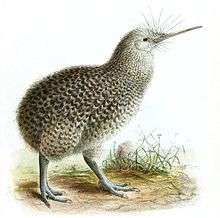
The culture of New Zealand is essentially a Western culture influenced by the unique environment and geographic isolation of the islands, and the cultural input of the indigenous Māori and the various waves of multi-ethnic migration which followed the British colonisation of New Zealand.
Polynesian explorers reached the islands between 1250 and 1300 CE. Over the ensuing centuries of Polynesian expansion and settlement, Māori culture developed from its Polynesian roots. Māori established separate tribes, built fortified villages (Pā), hunted and fished, traded commodities, developed agriculture, arts and weaponry, and kept a detailed oral history. Regular European contact began from 1800, and British immigration proceeded rapidly, especially from 1855. Colonists had a dramatic effect on the Māori, bringing Christianity, advanced technology, the English language, numeracy and literacy. In 1840 Māori chiefs signed the Treaty of Waitangi, intended to enable the tribes to live peacefully with the colonists. However, after several incidents, the New Zealand wars broke out from 1845, with Māori suffering a loss of land, partly through confiscation, but mainly through widespread and extensive land sales. Māori retained their identity, mostly choosing to live separately from settlers and continuing to speak and write te reo Māori. With mass migration from Britain, a high Māori death rate and low life expectancy for Māori women, the indigenous population figure dropped between 1850 and 1930, becoming a minority.
European New Zealanders (Pākehā), despite their location far from Europe, retained strong cultural ties to "Mother England".[1] These ties were weakened by the demise of the British Empire and loss of special access to British meat and dairy markets. Pākehā began to forge a separate identity influenced by their pioneering history, a rural lifestyle and New Zealand's unique environment. Pākehā culture became prevalent after the wars, but after sustained political efforts, biculturalism and the Treaty of Waitangi became part of the school curriculum in the late 20th century, to promote understanding between Māori and Pākehā.
More recently, New Zealand culture has been broadened by globalisation and immigration from the Pacific Islands, East Asia and South Asia. Non-Māori Polynesian cultures are apparent, with Pasifika, the world's largest Polynesian festival, now an annual event in Auckland.
New Zealand marks two national days of remembrance, Waitangi Day and ANZAC Day, and also celebrates holidays during or close to the anniversaries of the founding dates of each province.[2] New Zealand has two national anthems of equal status; "God Save the Queen" and "God Defend New Zealand"[3]—the latter of which is often sung with alternating Māori and English verses.[4] Many citizens prefer to minimise ethnic divisions, simply calling themselves New Zealanders or Kiwis.
Māori culture
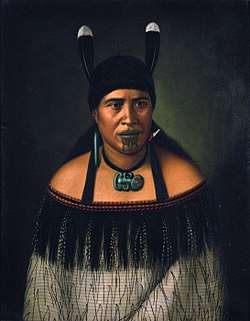
Hinepare of Ngati Kahungunu, is wearing a traditional korowai cloak adorned with a black fringe border. The two huia feathers in her hair, indicate a chiefly lineage. She also wears a pounamu hei-tiki and earring, as well as a shark tooth (mako) earring. The moko-kauae (chin-tattoo) is often based on one's role in the iwi.
The Māori are the indigenous inhabitants of New Zealand. They originated with settlers from eastern Polynesia, who arrived in New Zealand in several waves of canoe voyages at some time between 1250 and 1300 CE.[5][6] Māori settled the islands and developed a distinct culture over several hundred years. Oral history tells of a long voyage from Hawaiki (the mythical homeland in tropical Polynesia) in large ocean-going canoes (waka).[7] Māori mythology is a distinctive corpus of gods and heroes, sharing some Polynesian motifs. Significant figures are Ranginui and Papatūānuku, Māui, and Kupe.[7]
Central to many cultural events is the marae,[8] where families and tribes gather for special occasions, such as pōwhiri or tangi. Māori often call themselves "tāngata whenua" (people of the land), placing particular importance on a lifestyle connected to land and sea.[9] Communal living, sharing, and living off the land are strong traditional values.
The distinct values, history, and worldview of Maori are expressed through traditional arts and skills such as haka, tā moko, waiata, carving, weaving, and poi. The concept of tapu (meaning taboo or sacred[10]) is also a strong force in Māori culture, applied to objects, people, or even mountains.[11]
Europeans migrated to New Zealand in increasing numbers from 1855. Māori traditionally had a penchant for war, especially between 1805 and 1842 during the Musket Wars and diseases introduced, destabilized the traditional Māori society. The Treaty of Waitangi 1840 formed the basis of the establishment of British rule over New Zealand.[12] New Zealand became partly self-governing in 1852 with the establishment of its own Parliament. The most serious conflict between Māori and European settlers was between 1863 and 1864 which resulted in land being confiscated from the defeated tribes. However Māori sold most of their land after 1870 and continued to do so until the 1980s. From 1820 Maori entered a long period of cultural and numerical decline. However their population began to increase again from the late 19th century, and a cultural revival began in the 1960s, sometimes known as the Māori Renaissance.[13]
Pākehā culture
.jpg)
Pākehā culture (usually synonymous with New Zealand European culture) derives mainly from that of the British, particularly English settlers who colonised New Zealand in the nineteenth century. Until about the 1950s many Pākehā saw themselves as a British people, and retained strong cultural ties to "Mother England".[1] Yet there was a common perception that people born in New Zealand were likely to be physically stronger and more adaptable than people in Britain.[15] The largely rural life in early New Zealand led to the image of New Zealanders being rugged, industrious problem solvers.[14][16] Another distinctive trait of Pākehā culture has been the egalitarian tradition, as opposed to the British class system.[17] Within Pākehā culture there are also sub-cultures derived from Irish, Italian and other European groups,[18] as well as various non-ethnic subcultures.
It has been claimed that Pākehā do not actually have a culture, or if they do it is not a distinct one. Part of the problem is that high culture is often mistaken for culture in general, and the lack of recognition historically given to New Zealand's artists, writers and composers is seen as evidence of a lack of culture. In contrast, Pākehā pop culture is generally highly visible and valued. Others argue that belief in the 'absence' of culture in NZ is a symptom of white privilege, allowing members of a dominant group to see their culture as 'normal' or 'default', rather than as a specific position of relative advantage.[19] One of the goals of Pākehā anti-racist groups of the 1980s was to enable Pākehā to see their own culture as such, rather than thinking what they did was normal and what other people did was 'ethnic' and strange.[20]
From the 1980s Pākehā began to further explore their distinctive traditions and to argue that New Zealanders had a culture which was neither Māori nor British. There was an interest in "Kiwiana"—items from New Zealand's heritage that are seen as representing iconic Kiwi elements, such as the pōhutukawa (New Zealand Christmas tree), pāua-shell ash-tray, Buzzy Bee, Pineapple Lumps, gumboots and jandals.[21][22]
Other ethnic cultures
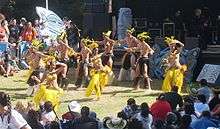
Ethnic communities within New Zealand retain features of their own cultures, and these have, in some areas, spread to become popular with the general population. Settler groups from many cultures added to the make-up of the country, with many groups concentrated around specific geographic areas. These include Dalmatian settlers in Northland, Danish settlers in inland Hawke's Bay, and Southern Chinese and Levantine settlers in Otago. These added to larger-scale Pākehā settlement which itself varied between English settlers (e.g., in Canterbury), Irish settlers (e.g., on the South Island West Coast), and Scottish settlers (e.g., in Otago and Southland).
From the mid twentieth century on, waves of immigrants have entered the country from different ethnic backgrounds, notable Dutch and central Europeans during the 1950s, Pacific Islanders since the 1960s, and northern Chinese, Indians, and southeast Asians since the 1980s.[23] Various aspects of each culture have added to New Zealand culture; Chinese New Year is celebrated for example, especially in Auckland and Dunedin,[24] and South Auckland has strong Samoan cultural links. To celebrate its diverse Pacific cultures, the Auckland region hosts several Pacific Island festivals. Two of the major ones are Polyfest, which showcases performances of the secondary school cultural groups in the Auckland region,[25] and Pasifika, a festival that celebrates Pacific island heritage through traditional food, music, dance, and entertainment.[26]
The popular music style of Urban Pasifika also has its origins in the New Zealand Pacific Island community, and has become a major strand in New Zealand music culture. The annual Pacific Music Awards recognise the contribution to New Zealand music made by Pacific Island musicians and musical styles. Pacific island heritage is also celebrated in much of New Zealand's fine art, with notable artists such as Fatu Feu'u, Lily Laita, John Pule, Yuki Kihara, and Michel Tuffery all heavily influenced by their Pacific origins.
Cultural borrowing and adaptation
Māori borrowing from Pākehā culture
Since the arrival of Europeans, Māori have been receptive adopters of most aspects of Pākehā culture. From the 1830s many Māori nominally converted to Christianity and in the process learned to read and write, by the late nineteenth century New Zealand when formal schooling finished for most at 12, Māori were as likely to be literate as Pākehā. A number of religions, such as Pai Mārire and Ringatū, arose in the nineteenth century, blending Māori tradition and Christianity.
Similarly Māori traditional chants were put to Victorian music, or written to European tunes, European designs and metal tools adopted by carvers, altering their style and British fabrics and cloth, such as blanketing adopted to form new dress. The horse was adopted, particularly on the East coast. European tools and particularly weapons were frequently decorated with traditional motifs, for example wooden musket and rifle stocks acquired elaborate carving. From the 1820s Māori began building vessels in the European boat building tradition. Many of these activities were conducted in collaboration with Pākehā traders and settlers.
After the defeat of rebel Māori who attempted to establish a renegade state in the King Country, the adoption of Pākehā culture became less of a free choice as Pākehā began to outnumber Māori. Parliament to passed legislation affecting Māori, such as the Native Schools Act (1867) which required English to be the dominant medium of instruction for Māori children although this was weakly enforced.[27] The majority of Māori encouraged their children to learn the English language and Pākehā ways of life to function economically and socially. From the 1880s a small number of western educated graduates emerged from Māori colleges such as Te Aute. Men such as Pomare, Ngata and Buck believed that further adopting Pakeha culture would advance Māori in New Zealand. Together they formed the Young Māori Party which was very influential in starting improved health and education for Māori. All believed to some extent in redeveloping an interest in Māori arts and craft.[28] Ngata went on to become a leading New Zealand politician and acting Prime Minister. Māori traditional culture became less critical in normal everyday life as advanced western technology- electricity, lights telegraphy, roads, mass production radio, aeroplanes and refrigeration[29] made most aspects of Māori culture redundant but was still practiced at events such as tangi(funerals).[30] From the early twentieth century and especially from the 1970s, Māori activists began to protest against Eurocentrism and demanded equal recognition for their own culture.
Many Māori have become successful practitioners of European-derived art forms; indeed many of New Zealand's biggest arts success stories are Māori or part Māori. These include opera singers Inia Te Wiata and Kiri Te Kanawa, novelists Keri Hulme (winner of the Booker Prize) and Alan Duff, poet Hone Tuwhare and painter Ralph Hotere, actors Temuera Morrison and Cliff Curtis and director Lee Tamahori. Māori culture has also provided inspiration to Pākehā artists.
Pākehā borrowing from Māori culture
Since the late nineteenth century, Pākehā have used Maori cultural practices when they required something distinctive. The most famous example of this is the haka of the All Blacks, a Māori posture dance which is performed before international rugby matches (there are many non-Māori Polynesian All Blacks, thus making this a multi-ethnic borrowing). However Pākehā artists such as Colin McCahon and Gordon Walters have also incorporated Māori motifs into their art, and a number of early Pākehā writers used Māori themes and topics in an effort to create an authentically New Zealand literature.[31] The tourist industry has also made heavy use of Māori culture in an effort to present tourists with distinctly New Zealand experiences and items. Many Pākehā in other countries use an aspect of Māori culture to express their New Zealandness. An example of this is the mass haka which takes place in Parliament Square in London every Waitangi Day. Although Māori are generally involved, most participants are Pākehā (See Hei-tiki.)
For many years Pākehā did not consult Māori over the use of their culture, and Māori generally did not protest loudly unless a symbol was being used in a particularly inappropriate way. From the 1970s, Māori increasingly began to object to Pākehā use of their culture, especially when this use was disrespectful. One example of this is the "haka party attack" of 1979. University of Auckland engineering students had a tradition of performing a mock haka at graduation. After pleas from Māori students to discontinue the practice were ignored, a group assaulted the engineering students. They were later charged with assault but defended by Māori elders who testified that the engineers' haka was deeply offensive.[32] Most Pākehā are now more respectful of Māori culture and often consult Māori before using Māori cultural forms. However, despite some attempts to copyright cultural intellectual property this does not always occur and forms are still sometimes used in inappropriate ways.
Some Pākehā have been deeply involved in the revival of otherwise lost Māori arts. In the performance of traditional Māori musical instruments Richard Nunns has earned wide respect, as have the contributions made by many academics, for example, Dame Anne Salmond in the area of traditional rituals of encounter, or Mervyn McLean in the analysis of traditional song. Māori history has mainly been written by Pakeha authors such as Michael King, James Belich and Paul Moon. Traditionally Māori were reluctant to reveal their tribal knowledge to Europeans for fear of being mocked or considered barbaric, and also a belief in keeping tribal secrets. When Kingitanga allowed Michael King to write the biography of "Princess" Te Puea, because of his sensitivity to Māori, they still withheld material that would not show her in a good light.
Borrowing from overseas
Both Māori and Pākehā have borrowed cultural forms and styles from other countries, particularly Britain and the United States. Most popular New Zealand music derives from Anglo-American styles, particularly rock music, hip-hop, electronic dance music and related subgenres. Although there is evidence of a "New Zealand style", many groups incorporate New Zealand themes into their work, so this style affects each genre differently. More recently however from the start of the 21st century Dubstep, Drum and Bass, Jungle Trance and related subgenres, derived from England, has been further developed by New Zealanders into a unique sound, exemplified by Salmonella Dub, Shapeshifter and many others.
The visual arts have also shown the influence of international movements, for example cubism in the early work of Colin McCahon. In general, the development of international mass media and mass communication has meant New Zealanders have always been aware of developments in other countries; this lends itself to the adoption of new forms and styles from overseas.
Languages
New Zealand has three official languages: New Zealand English, Te Reo Māori (the Māori language), and New Zealand Sign Language.[33] In practice only English is widely used although major efforts have been made in recent years to nurture Te Reo. Numerous other languages are spoken in New Zealand due to its high racial diversity as a country.
New Zealand English
New Zealand English is close to Australian English in pronunciation, but has several differences often overlooked by people from outside these countries. The most prominent differences between the New Zealand English dialect and other English dialects are the shifts in the short front vowels: the short-"i" sound (as in "kit") has centralised towards the schwa sound (the "a" in "comma" and "about"); the short-"e" sound (as in "dress") has moved towards the short-"i" sound; and the short-"a" sound (as in "trap") has moved to the short-"e" sound.[34] Some of these differences show New Zealand English to have more affinity with the English of southern England than Australian English does. Several of the differences also show the influence of Māori speech. The New Zealand accent also has some Scottish and Irish influences from the large number of settlers from those places during the 19th century. At the time of the 2013 census, English was spoken by 96.1% of the total population.[35]
Te Reo Māori
An Eastern Polynesian language, Te Reo Māori, is closely related to Tahitian and Cook Islands Māori; slightly less closely to Hawaiian and Marquesan; and more distantly to the languages of Western Polynesia, including Samoan, Niuean and Tongan. The language went into decline in terms of use following European colonisation, but since the 1970s mildly successful efforts have been made to reverse this trend. These include the granting of official language status through the Māori Language Act 1987,[33] a Māori language week and a Māori Television channel. The 2013 census found that Māori was spoken by 3.7% of the population.[35]
Historically, there were distinct dialects of Te Reo, most notably a softer version associated with the southern extreme of the country, though these have been almost completely subsumed by a standardised dialect originally found around the Waikato area.
New Zealand Sign Language
New Zealand Sign Language has its roots in British Sign Language (BSL), and may be technically considered a dialect of British, Australian and New Zealand Sign Language (BANZSL). There are 62.5% similarities found in British Sign Language and NZSL, compared with 33% of NZSL signs found in American Sign Language. Like other natural sign languages, it was devised by and for Deaf people, with no linguistic connection to a spoken or written language, and it is fully capable of expressing anything a fluent signer wants to say. It uses more lip-patterns in conjunction with hand and facial movement to cue signs than BSL, reflecting New Zealand's history of oralist education of deaf people. Its vocabulary includes Māori concepts such as marae and tangi, and signs for New Zealand placenames. New Zealand Sign Language became an official language of New Zealand in April 2006.[33] About 20,000 people use New Zealand Sign Language.[36]
Other languages
According to the 2013 census, 174 languages are used in New Zealand (including sign languages). As recorded in the 2013 census, Samoan is the most widely spoken non-official language (2.2%), followed by Hindi (1.7%), "Northern Chinese" (including Mandarin, 1.3%) and French (1.2%).[35]
Arts
New Zealand has two 'high cultural' traditions: Māori and Western. However most cultural material consumed in New Zealand is imported from overseas, particularly from Britain and the United States. Because of this and New Zealand's small population, most New Zealand artists, performers and writers struggle to make a living from their art. Some funding for the arts is provided through a specific arts based government department, Creative New Zealand. Heritage New Zealand and the Ministry for Culture and Heritage are national bodies that assist with heritage preservation. Most towns and cities have museums and often art galleries, and the national museum and art gallery is Te Papa ('Our Place'), in Wellington.
Visual arts
Pre-Colonial Māori visual art had two main forms: carving and weaving. Both recorded stories and legends and also had religious roles.
When Settlers arrived, they brought with them Western artistic traditions. Early Pākehā art focussed mainly on landscape painting, although some of the best known Pākehā artists of the nineteenth century (Charles Goldie and Gottfried Lindauer) specialised in Māori portraiture. Some Māori adopted Western styles and a number of nineteenth century meeting houses feature walls painted with portraits and plant designs. From the early twentieth century Āpirana Ngata and others began a programme of reviving traditional Māori arts, and many new meeting houses were built with traditional carving and tukutuku woven wall panels were built. A longstanding concern of Pākehā artists has been the creation of a distinctly New Zealand artistic style. Rita Angus and others used the landscape to try and achieve this while painters such as Gordon Walters used Māori motifs. A number of Māori artists, including Paratene Matchitt and Shane Cotton have combined Western modernism with traditional Māori art.
Performing arts
Kapa haka
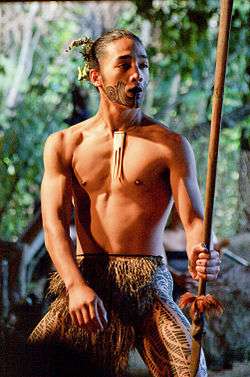
Kapa haka, (kapa meaning 'rank' or 'row' and haka referring to a Māori dance), is the 'cultural dance' component of traditional Māori Performing Arts. Kapa haka is an avenue for Māori people to express their heritage and cultural identity through song and dance. It has undergone a renaissance, with national competitions held yearly and kapa haka used in many state occasions. The haka (often mistaken as always being a war dance or ritual challenge) has become part of wider New Zealand culture, being performed by the All Blacks as a group ritual before international games and by homesick New Zealanders of all races who want to express their New Zealandness.[37]
Drama
New Zealand drama, both on stage and screen, has been plagued during much of its history by cost and lack of popular interest in New Zealand culture. Despite this Roger Hall and, more recently, Jacob Rajan are two playwrights to achieve considerable popular success. In recent decades New Zealand film has grown dramatically, with the films Once Were Warriors, The Piano and Heavenly Creatures doing well both locally and internationally, and The Lord of the Rings trilogy director Peter Jackson becoming one of film's most successful directors. New Zealand's most popular comedian was the late Billy T. James.
Music
.jpg)
New Zealand music has been influenced by blues, jazz, country, rock and roll and hip hop, with many of these genres given a unique New Zealand interpretation.[38][39] Hip-hop is popular and there are small but thriving live music, dance party and indie music scenes. Reggae is also popular within some communities, with bands such as Herbs, Katchafire, 1814, House Of Shem, Unity Pacific all reflecting their roots, perspectives and cultural pride and heritage through their music.
A number of popular artists have gone on to achieve international success including Lorde,[40] Split Enz, Crowded House, OMC, Bic Runga, Kimbra, Ladyhawke, The Naked and Famous, Fat Freddy's Drop, Savage, Flight of the Conchords, and Brooke Fraser.
New Zealand has a national orchestra and many regional orchestras. A number of New Zealand composers have developed international reputations. The most well-known include Douglas Lilburn,[41] John Psathas,[42] Jack Body,[43] Gillian Whitehead,[44] Jenny McLeod,[45] Gareth Farr,[46] Ross Harris,[47] and Martin Lodge.[48]
Comedy
In recent decades New Zealand comics have risen in popularity and recognition. In the 1970s and 1980s Billy T James satirized race relations, and McPhail & Gadsby lampooned political figures, especially Robert Muldoon. John Clarke aka Fred Dagg joked about rural life. From the 1990s onwards the Naked Samoans expressed a Polynesian sense of humour to the nation, and Raybon Kan is a prominent Asian comic and columnist. The Topp Twins are an off-beat comic/country music duo, and Flight of the Conchords have become famous throughout the English-speaking world for their self-effacing show.
Literature
.jpg)
New Zealand's most successful early writers were expatriates such as Katherine Mansfield. From the 1950s, Frank Sargeson, Janet Frame and others had (non lucrative) writing careers while still living in New Zealand. Until about the 1980s, the main New Zealand literary form was the short story, but in recent decades novels such as Alan Duff's Once Were Warriors, Elizabeth Knox's The Vintner's Luck and others have achieved critical and popular success. Māori culture is traditionally oral rather than literate, but in recent years Māori novelists such as Duff, Witi Ihimaera and Keri Hulme and poets such as Hone Tuwhare have shown their mastery of literary forms. Austin Mitchell wrote two "Pavlova Paradise" books about New Zealand. Barry Crump was a popular author who embodied and expounded the myth of the Kiwi larrikin and multi-skilled labourer. Sam Hunt and Gary McCormick are well-known poets. James K Baxter was an eccentric but admired author. Maurice Gee is also a household name for his novels about New Zealand life.
New Zealand cartoonist David Low became famous during World War II for his political satire. Gordon Minhinnick and Les Gibbard were also witty political observers. Murray Ball drew a widely popular syndicated daily strip Footrot Flats, about farm life.
Sports
The sports that most New Zealanders participate in are rugby union, cricket, basketball, netball, association football (the most popular sport amongst children), rugby league and hockey.[49] Also popular are golf, tennis, cycling and a variety of water sports, particularly sailing and rowing. The country is known for its extreme sports, adventure tourism and strong mountaineering tradition, as seen in the success of notable New Zealander Sir Edmund Hillary.[50]
The national rugby union team is called the All Blacks and has the best winning record of any national team in the world,[51] including being the inaugural winners of the World Cup in 1987. The style of name has been followed in naming the national team in several other sports. For instance, the nation's basketball team is known as the Tall Blacks.
Horseracing was also a popular spectator sport and became part of the "rugby, racing and beer" culture during the 1960s. Many New Zealanders either play or support their local rugby team and the All Blacks are national icons.[52] Some have argued that rugby is a national religion.[53]
Religion
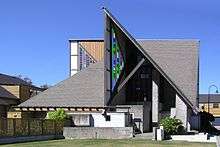
Pre-Colonial native Māori religion was polytheistic. One of its major features was tapu (sacred and/or forbidden), which was used to maintain the status of chiefs and tohunga (priests) and also for purposes such as conserving resources. Some of the earliest European settlers in New Zealand were Christian missionaries, mostly from the Church of England but also from Protestant denominations and the Catholic Church. From the 1830s onwards, large numbers of Māori converted. Throughout the nineteenth century a number of movements emerged which blended traditional Māori beliefs with Christianity. These included Pai Marire, Ringatu, and in the early twentieth century, Ratana. They typically centred on a prophet-leader. These churches continue to attract a substantial following; according to the 2013 census, 50,565 people are Ratana believers, and another 16,419 are Ringatu. 1,689 people stated that they followed Māori religion. Many Māori members of mainstream churches, and those with no particular religion, continue to believe in tapu, particularly where the dead are concerned, although not to the same extent as their ancestors.
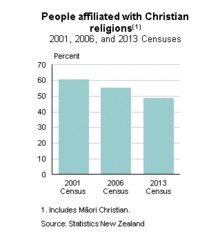
Pākehā have become steadily less religious over the course of the twentieth century. In the 1920s there was still a reasonably high level of sectarianism and anti-Catholic prejudice, but this has since died down and the major churches generally co-operate with each other. The churches and religious lobby groups have little political influence where Pākehā are concerned. The vast majority of religious Pākehā are Christian, but a small number follow non-Christian religions, particularly Buddhism, and a larger number have a vague belief in new age ideas such as the healing power of crystals.
In 2013, the number of people who affiliated with a Christian denomination (including Māori Christian) decreased to 1,906,398 (48.9% of all people who stated their religious affiliation), down from 2,082,942 (55.6%) in 2006.[54] Affiliation to non-Christian religions has increased since the 2006 census. As of 2013, the number of Hindus numbered 88,919, Muslims 46,149 and Sikhs 19,191. The number and proportion of people indicating they had no religion increased between 2006 and 2013.[54] In 2013, more than 2 in 5 people (41.9 percent) reported they had no religion. 1,635,345 New Zealanders identified with no religion at the 2013 census.[54]
Class in New Zealand
Māori hierarchies
Māori society has traditionally been one based on rank, which derived from ancestry (whakapapa). Present-day Māori society is far less hierarchical than it traditionally was, although it is still stratified by Pākehā standards. A disproportionate number of Māori MPs come from chiefly families, for example. However, a number of Māori not born into the chiefly families have achieved positions of considerable mana within their communities by virtue of their achievements or learning.
The 'classless society'
Until about the 1980s it was often claimed that New Zealand was a 'classless society'.[55] The evidence for this was the relatively small range of wealth (that is, the wealthiest did not earn hugely more than the poorest earners), lack of deference to authority figures, high levels of class mobility, a high standard of working class living compared to Britain, progressive labour laws which protected workers and encouraged unionism, state housing, and a welfare state which was developed in New Zealand before most other countries.
New Zealanders' egalitarianism has been criticised as discouraging and denigrating ambition and individual achievement and success. New Zealanders tend to value modesty and distrust those who talk about their own merits. They especially dislike anyone who seems to consider themselves better than others even if the person in question is demonstrably more talented or successful than others. This attitude can manifest itself in the tall poppy syndrome, which describes the 'cutting down' of anyone thought to have risen above the general mass of people.[56][57]
It has been argued that in New Zealand ethnicity takes the place of class, with Māori and other Polynesians earning less, having a lower standard of living and less education, and working in lower status jobs than Pākehā.[58]
New Zealand's claims to be a classless society were dealt a fatal blow in the 1980s and 1990s by the economic reforms of the fourth Labour government and its successor, the fourth National government. A cultural shift also took place due to the economic and social impact of international capital, commerce and advertising. New Zealanders were exposed to a previously unknown array of consumer goods and franchises. Aided by overseas programming, commercial radio and TV stations enjoyed rapid growth. Local manufacturing suffered from cheap imports, with many jobs lost. These reforms led to a dramatic increase in the gap between the richest and poorest New Zealanders, and an increase in the numbers living in poverty.[59]
Travel
It is very common for New Zealanders to travel or live overseas for extended periods of time, often on working holidays. These are usually referred to as the 'OE' or 'overseas experience', and are most commonly taken by people in their 20s. The three most common destinations are Australia, Great Britain and Europe, although recently trips to Asian countries such as South Korea and Japan to teach English have become increasingly popular. The east coast of Australia and London both have sizeable expatriate New Zealand communities.
The OE to Europe is usually self-funded, and tends to occur a few years after university graduation, when the traveller has saved up enough for airfares and living expenses. The length of the visit can range from a few months to the remainder of the visitor's life; since many New Zealanders have British ancestry or dual citizenship (sometimes as a result of their parents' OE), the restrictions on working in Britain do not apply to a substantial percentage of them.
Working holidays in Asia are more likely to occur shortly after graduation, and many agencies specifically target graduates for these trips. Because Australia is relatively close to New Zealand and has no restrictions on New Zealanders working there, the New Zealanders working in Australia are more diverse than those in other countries, with a significantly higher proportion of Māori and working-class people.
Since the signing of the Trans-Tasman Travel Arrangement in 1973, New Zealanders have had the right to live and work in Australia on equal terms with Australian citizens. Until the 1970s New Zealanders had similar rights in relation to Britain. Changes to British immigration law in this period required New Zealanders to obtain visas to work in Britain or live there for extended periods, unless they had recent British ancestry.
New Zealand has a number of reciprocal working holiday agreements, allowing people in their 20s to live and work overseas, usually for up to a year. Such agreements are in place with: Argentina, Belgium, Brazil, Canada, Chile, Czech Republic, Denmark, Finland, France, Germany, Hong Kong, Republic of Ireland, Italy, Japan, South Korea, Malaysia, Malta, Mexico, Netherlands, Norway, Singapore, Spain, Sweden, Taiwan, Thailand, the United Kingdom and Uruguay.[60]
National stereotypes
The Kiwi male
The stereotypical New Zealand male is essentially a pioneer type: he is perceived to be rural, unintellectual, strong, unemotional, democratic, has little time for high culture, good with animals (particularly horses) and machines, and is able to turn his hand to nearly anything. This type of man is often presumed to be a unique product of New Zealand's colonial period but he shares many similarities with the stereotypical American frontiersman and Australian bushman. New Zealand men are supposed to still have many of these qualities, even though most New Zealanders have lived in urban areas since the late nineteenth century. This has not prevented New Zealanders seeing themselves (and being seen) as essentially country people and good at the tasks which country life requires.[61]
- The hard man: New Zealand men have often been stereotyped as strong, unemotional and prone to violence.[62] For many years this was seen as a good thing, and was best embodied by All Black Colin Meads. Voted 'New Zealand player of the century' by New Zealand Rugby Monthly magazine, Meads was the second All Black to be sent off the field, and once played a match with a broken arm. Although he was known to assault other players during games, this was generally approved of as 'enforcement' of the 'spirit of the game'.[63] He was also a supporter of sporting contact with apartheid South Africa. In recent decades the macho attitude has been both criticised and reviled as dangerous both to men who embody it and those around them. It has been blamed for New Zealand's culture of heavy drinking and its high male suicide rate.[64]} However it still has its supporters, with some commentators claiming that the more recent All Blacks do not have enough 'mongrel'.[65]
Attitudes
Social conservatism and progressiveness
New Zealand social policy has tended to oscillate between high levels of innovation and progressiveness and equally high levels of conservatism. Social reforms pioneered by New Zealand include women's suffrage, the welfare state, and respect for indigenous peoples (through the Treaty of Waitangi and the Waitangi Tribunal). Having led the (non-communist) world in economic regulation from the 1930s, in the 1980s and 1990s the reforms of the Labour Government led the world in economic de-regulation. New Zealand was the first country to have an openly transgender mayor, and later member of parliament, Georgina Beyer.
In contrast to this, New Zealand has a history of some very conservative social policies. Most notably, from World War One until 1967 pubs were required by law to close at 6pm.[66] Until the 1980s most shops were banned from opening on weekends, and until 1999 alcoholic beverages could not be sold on Sundays, known as blue law.
In a rare occurrence, the 1981 Springbok Tour saw the two extremes very publicly clash with each other on a nationwide scale.[67]
Attitudes to authority
Most New Zealanders display faith in their democracy, with New Zealand being rated the second least corrupt nation in the world.[68] Turnout for parliamentary elections is typically above 80%, which is very high by international standards and occurs despite the absence of any law requiring citizens to vote. However local government elections have much lower turnout figures, with an average of 53% in 2007.[69]
New Zealanders, both those of Pākehā and Māori roots, have been described as an individualistic people, who take intrusion very personally, especially when it occurs onto private land (but also sometimes in a wider sense). According to psychologists, this is rooted respectively in the 'frontier' image of the European settler culture, but also mirrored amongst the Māori, for whom land holds a lot of spiritual value in addition to its commercial use.[70]
Attitudes to multiculturalism
New Zealand has for most of its modern history been an isolated bi-cultural society. In recent decades an increasing number of immigrants has changed the demographic spectra. In the larger cities this change has occurred suddenly and dramatically. There has been an increasing awareness of multiculturalism in New Zealand in all areas of society and also in politics. New Zealand's race relations has been a controversial topic in recent times. The political party New Zealand First has been associated with an anti immigration policy. The Office of the Race Relations Conciliator was established by the Race Relations Act in 1971[71] for the purposes of "promoting positive race relations and addressing complaints of discrimination on grounds of race, colour, and ethnic or national origin", and was merged with the Human Rights Commission in January 2002.[72]
Food
Māori cuisine
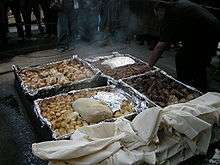
Māori cuisine was historically derived from that of tropical Polynesia, adapted for New Zealand's colder climate. Key ingredients included kūmara (sweet potato), fern root, taro, birds and fish. Food was cooked in hāngi (earth ovens) and roasted, and in geothermal areas was boiled or steamed using natural hot springs and pools. Various means of preserving birds and other foods were also employed. Māori were one of the few peoples to have no form of alcoholic beverage.
Following the arrival of British settlers, Māori adopted many of their foods, especially pork and potatoes, the latter of which transformed the Māori agricultural economy. Many traditional food sources became scarce as introduced predators dramatically reduced bird populations, and forests were cleared for farming and timber. Traditional seafoods such as toheroa and whitebait were over-harvested. Present day Māori cuisine is a mixture of Māori tradition, old fashioned English cookery, and contemporary dishes. In everyday life the two foods of Māori origin are "the boil up" (boiled up left over food meat and vegetable scraps sometimes thickened with flour), and the hāngi which is associated with special occasions.[73]
Pākehā cuisine
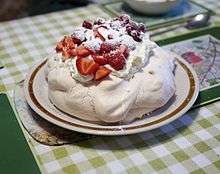
The majority of Pākehā are of British descent, and so it is not surprising that Pākehā cuisine is very similar to British cuisine. Nineteenth-century British settlers in New Zealand tried as much as possible to reproduce the foods of their homeland. A major difference between British and Pākehā food was that meat was much more readily available to all social classes in New Zealand. A highly carnivorous diet remains a part of Pākehā culture, although red meat consumption has dropped in the last few decades. Like the British, Pākehā have traditionally been very fond of sweet foods, and the best of traditional Pākehā cooking consists of cakes, scones, muffins and desserts.
In recent decades Pākehā have discovered 'ethnic' food, and a 'foodie' culture has emerged. Most Pākehā food is not significantly different from modern British cuisine, although New Zealand chefs such as Peter Gordon played a major part in the creation of fusion cuisine.
Other cuisines
New Zealanders increasingly come from many ethnic backgrounds, and most immigrants to New Zealand have tried to reproduce their native cuisines or national dishes in New Zealand. Ethnic restaurants have served as community meeting places and have also given other New Zealanders a chance to try different cuisines.
The evolution of café culture has been a major part of growth within New Zealand. Cafés and the perfection of espresso coffee making throughout most of New Zealand have led to a unique part of the life of the country.[74]
See also
Citations
- 1 2 Laugesen, Ruth (11–17 July 2009). "Past tense". New Zealand Listener. 219 (3609). Archived from the original on 8 August 2009. Retrieved 7 April 2013.
- ↑ "Government and nation – National holidays". Te Ara: The Encyclopedia of New Zealand. 3 March 2009. Retrieved 16 February 2010.
- ↑ "God Save the Queen" is also an official anthem but is rarely sung
- ↑ "Government and nation – National anthems". Te Ara: The Encyclopedia of New Zealand. 3 March 2009. Retrieved 16 February 2010.
- ↑ Minahan, James (2012). Ethnic Groups of South Asia and the Pacific: An Encyclopedia. ABC-CLIO. p. 218. ISBN 9781598846591.
- ↑ Wilson, John (February 2005). "History – Māori arrival and settlement". Te Ara – the Encyclopedia of New Zealand. Retrieved 21 August 2017.
- 1 2 Royal, Te Ahukaramū Charles (February 2005). "First peoples in Māori tradition". Te Ara – the Encyclopedia of New Zealand. Retrieved 21 August 2017.
- ↑ Keane, Basil (September 2013). "Marae protocol – te kawa o te marae". Te Ara – the Encyclopedia of New Zealand. Retrieved 21 August 2017.
- ↑ Royal, Te Ahukaramū Charles (September 2007). "Papatūānuku – the land – Whenua – the placenta". Te Ara – the Encyclopedia of New Zealand. Retrieved 21 August 2017.
- ↑ "Entries for TAPU [OC] Prohibited, under ritual restriction, taboo". Polynesian Lexicon Project Online. Retrieved 21 August 2017.
- ↑ Royal, Te Ahukaramū Charles (September 2007). "Te Ao Mārama – the natural world – Mana, tapu and mauri". Te Ara – the Encyclopedia of New Zealand. Retrieved 21 August 2017.
- ↑ Buick, T. Lindsay (2011). The Treaty of Waitangi: How New Zealand Became a British Colony. Cambridge University Press. p. 382. ISBN 9781108039963.
- ↑ Royal, Te Ahukaramū Charles (February 2005). "Māori – Urbanisation and renaissance". Te Ara – the Encyclopedia of New Zealand. Retrieved 20 August 2017.
- 1 2 Kennedy 2007, p. 400.
- ↑ Phillips, Jock (May 2015). "The New Zealanders". Te Ara – the Encyclopedia of New Zealand. Retrieved 20 August 2017.
- ↑ Phillips 1987.
- ↑ Easton, Brian (2016). Not In Narrow Seas: A Political Economy of New Zealand’s History. Otago: Otago University Press.
- ↑ Phillips, Jock (August 2015). "History of immigration". Te Ara – the Encyclopedia of New Zealand. Retrieved 20 August 2017.
- ↑ Tim McCreanor (2005), '"Sticks and Stones may break my bones. ..": Talking Pakeha Identities', in James H. Liu, Tim McCreanor, Tracey McIntosh and Teresia Teaiwa, eds, New Zealand Identities: Departures and Destinations, p.53.
- ↑ Miranda Johnson (2005), '"The Land of the Wrong White Cloud": Anti-Racist Organizations and Pakeha Identity Politics in the 1970s', New Zealand Journal of History, 39, 2, pp.137–57.
- ↑ "Kiwiana". www.newzealand.com. Tourism New Zealand. Retrieved 20 August 2017.
- ↑ Turner, Anna (24 October 2012). "Study up, bro: Kiwiana course to explore our culture". Stuff. Retrieved 24 August 2017.
- ↑ "History of immigration". Te Ara – the Encyclopedia of New Zealand. 8 February 2005. Retrieved 22 August 2017.
- ↑ "Auckland celebrates Chinese New Year". www.newshub.co.nz. Newshub. Retrieved 23 August 2017.
- ↑ "Polyfest NCEA credits / Pasifika Education Plan / Home – Pasifika". Te Kete Ipurangi (TKI). Retrieved 22 August 2017.
- ↑ "Thousands turn out for Pasifika Festival". Radio New Zealand. 25 March 2017. Retrieved 22 August 2017.
- ↑ Auditor General of NZ. Part 3 . Historical and Current Context of Maori Education.
- ↑ NZ History. Part 3. Maori and Pakeha relations.1900–1945.
- ↑ Te Ara. The NZ Encyclopedia. Story: Economic Development. p6 Refrigeration, Dairying and the Liberal Boom.
- ↑ 7th Joint Conference of "Preservation of Ancient Cultures--" G. Harmsworth.
- ↑ Jones 1998, pp. 123–4.
- ↑ Walker, Ranginui (1990), Ka Whawhai Tonu Matou: Struggle Without End, pp.221–5
- 1 2 3 "Government and nation – Official languages". Te Ara: The Encyclopedia of New Zealand. 3 March 2009. Retrieved 16 February 2010.
- ↑
- Bauer, Laurie; Warren, Paul; Bardsley, Dianne; Kennedy, Marianna; Major, George (2007), "New Zealand English", Journal of the International Phonetic Association, 37 (1): 97–102, doi:10.1017/S0025100306002830
- 1 2 3 "2013 Census QuickStats about culture and identity – Languages spoken". stats.govt.nz. Statistics New Zealand. Retrieved 8 September 2016.
- ↑ "New Zealand Sign Language (NZSL) Studies". Victoria University of Wellington. 25 August 2016. Retrieved 9 September 2016.
- ↑ "History of the All Black haka". Tourism New Zealand Media. Retrieved 18 August 2017.
- ↑ Swarbrick, Nancy (June 2010). "Creative life – Music". Te Ara – the Encyclopedia of New Zealand. Retrieved 21 January 2011.
- ↑ Southgate, William (September 1977). "Current Developments in New Zealand music". Composers Association of New Zealand newsletter: 25–27.
- ↑ "Lorde's 'Royals' Reigns On Hot 100 for Eighth Week".
- ↑ "Story: Lilburn, Douglas Gordon".
- ↑ "John Psathas composer profile".
- ↑ "Jack Body composer profile".
- ↑ "Gillian Whitehead composer profile".
- ↑ "Jenny McLeod composer profile".
- ↑ "Gareth Farr composer profile".
- ↑ "Ross Harris composer profile".
- ↑ "Martin Lodge composer profile".
- ↑ "Sports & Recreation in New Zealand". New Zealand Now. Retrieved 18 August 2017.
- ↑ "World mourns Sir Edmund Hillary". The Age. Melbourne. 11 January 2008.
- ↑ "The All Blacks guide to being successful (off the field)". Telegraph.co.uk. 14 November 2013. Retrieved 18 August 2017.
- ↑ "Sad our icon even has a price". New Zealand Herald.
- ↑ "Rugby, racing and beer – week to remember for Whitelock family". The New Zealand Herald. 10 February 2012.
- 1 2 3 "2013 Census QuickStats about culture and identity". www.stats.govt.nz. Statistics New Zealand.
- ↑ Sinclair, Keith (1969), A History of New Zealand, 2nd edn, p.285.
- ↑ Kennedy 2007, p. 399.
- ↑ "Does NZ still cut down tall poppies?", 18 March 2013, Adrien Taylor, 3news.co.nz
- ↑ Macpherson 1977, p. 99–112.
- ↑ Tim Hazledine (1998) Taking New Zealand Seriously: The Economics of Decency ISBN 1-86950-283-3
- ↑ NZ Ministry of Foreign Affairs and Trade website: http://www.mfat.govt.nz/Countries/index.php
- ↑ Phillips 1987, pp. 1–42.
- ↑ Phillips 1987, pp. 81–130.
- ↑ Colin Meads at AllBlacks.com
- ↑ Phillips 1987, pp. 261–89.
- ↑ Long, David (12 July 2009). "All Blacks need more mongrel". Sunday News. Fairfax. Retrieved 26 September 2011.
- ↑ "The 'six o'clock swill' – Sports and leisure – Te Ara: The Encyclopedia of New Zealand". Retrieved 30 September 2015.
- ↑ "Impact – 1981 Springbok tour – NZHistory, New Zealand history online". Retrieved 30 September 2015.
- ↑ Transparency International Website Rankings for 2008 Archived 11 March 2009 at the Wayback Machine.
- ↑ "Local Government Statistical Overview – Membership, Elections and Governance". Department of Internal Affairs, New Zealand. Retrieved 15 February 2010.
- ↑ Davison, Isaac (30 January 2010). "NZ independence is deeply rooted". New Zealand Herald. Retrieved 15 February 2010.
- ↑ "Background — Ministry of Justice, New Zealand". Retrieved 30 September 2015.
- ↑ http://www.hrc.co.nz/hrc_new/hrc/cms/files/documents/26-May-2005_21-42-45_Race_relations_summary.doc
- ↑ Maori hangi: Guide to how to make a Hangi.
- ↑ "New Zealand's dedicated coffee culture". newzealand.com. Tourism New Zealand. Retrieved 9 February 2012.
References
- Jones, Lawrence (1998). The Novel. , in Terry Sturm, ed., The Oxford History of New Zealand Literature in English
- Kennedy, Jeffrey (2007). "Leadership and Culture in New Zealand". In Chhokar, Jagdeep; Brodbeck, Felix; House, Robert. Culture and Leadership Across the World: The GLOBE Book of In-Depth Studies of 25 Societies. United States: Psychology Press. ISBN 978-0-8058-5997-3.
- Macpherson, Cluny (1977). Polynesians in New Zealand: An Emerging Eth-Class?. , in David Pitt, ed., Social Class in New Zealand
- Phillips, Jock (1987). A Man's Country? The Image of the Pakeha Male: A History. Auckland: Penguin Books.
External links
| Wikimedia Commons has media related to Culture of New Zealand. |
- Manatū Taonga, the Ministry for Culture and Heritage
- Kiwi Ingenuity
- Research in New Zealand Performing Arts – A free online research journal that discusses New Zealand music and related arts.
- New Zealand Cultural Events and Organisations

